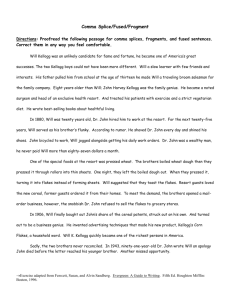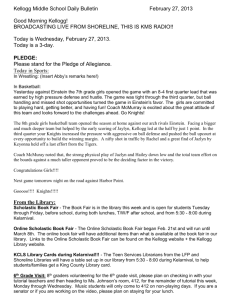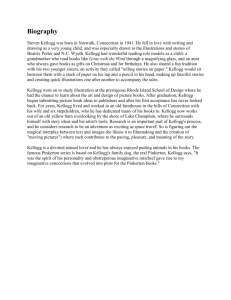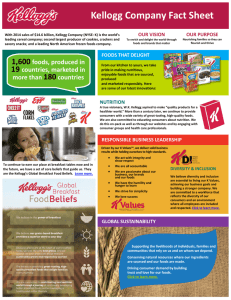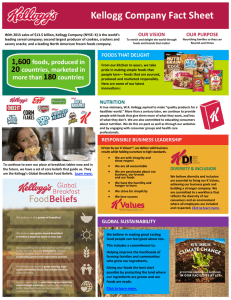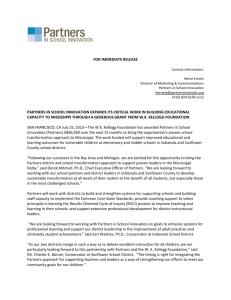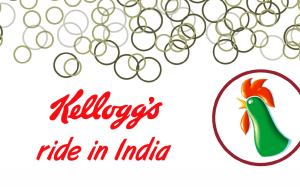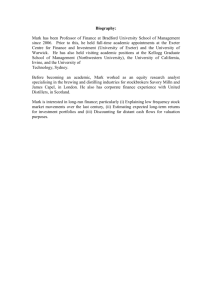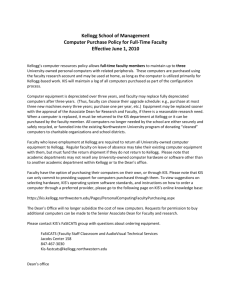chapter 3: strategy chapter 3: strategy chapter 3
advertisement
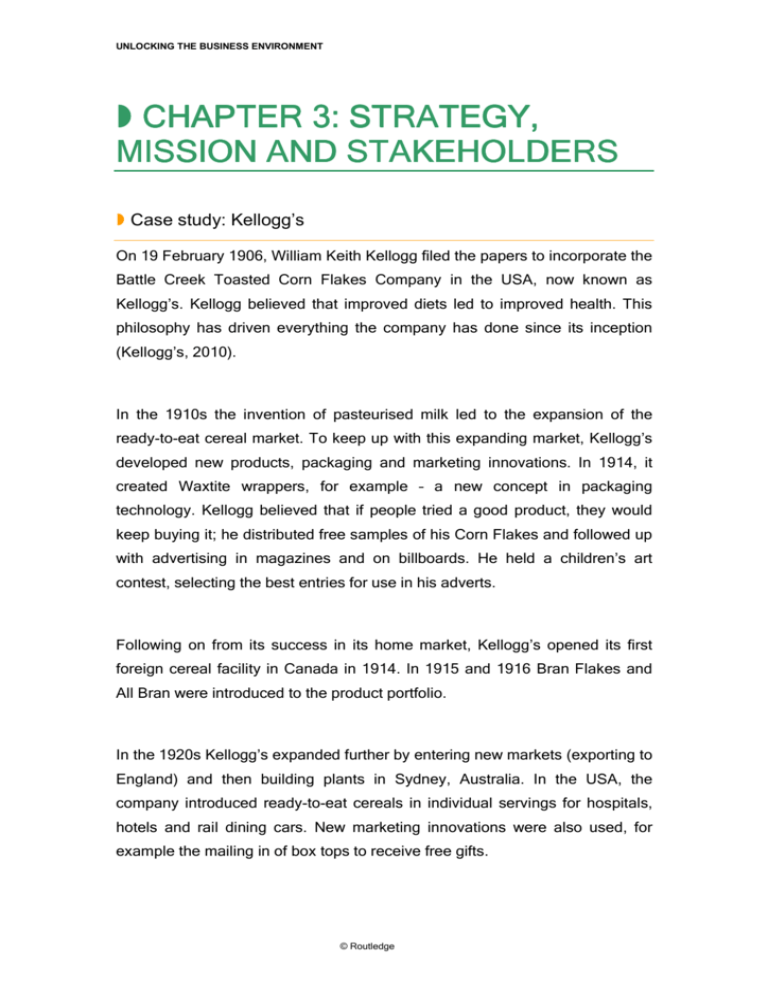
UNLOCKING THE BUSINESS ENVIRONMENT CHAPTER 3: STRATEGY, STRATEGY, MISSION AND STAKEHOL STAKEHOLDERS DERS Case study: Kellogg’s On 19 February 1906, William Keith Kellogg filed the papers to incorporate the Battle Creek Toasted Corn Flakes Company in the USA, now known as Kellogg’s. Kellogg believed that improved diets led to improved health. This philosophy has driven everything the company has done since its inception (Kellogg’s, 2010). In the 1910s the invention of pasteurised milk led to the expansion of the ready-to-eat cereal market. To keep up with this expanding market, Kellogg’s developed new products, packaging and marketing innovations. In 1914, it created Waxtite wrappers, for example – a new concept in packaging technology. Kellogg believed that if people tried a good product, they would keep buying it; he distributed free samples of his Corn Flakes and followed up with advertising in magazines and on billboards. He held a children’s art contest, selecting the best entries for use in his adverts. Following on from its success in its home market, Kellogg’s opened its first foreign cereal facility in Canada in 1914. In 1915 and 1916 Bran Flakes and All Bran were introduced to the product portfolio. In the 1920s Kellogg’s expanded further by entering new markets (exporting to England) and then building plants in Sydney, Australia. In the USA, the company introduced ready-to-eat cereals in individual servings for hospitals, hotels and rail dining cars. New marketing innovations were also used, for example the mailing in of box tops to receive free gifts. © Routledge UNLOCKING THE BUSINESS ENVIRONMENT In the 1930s (the Great Depression), rather than cutting back the company doubled its spending on advertising and its sales increased. The company continued to expand with a new plant in the UK (Manchester). Kellogg’s Pep was introduced as the first fortified cereal. In the 1940s Kellogg’s provided packaged K-rations for US armed forces during the Second World War. Rice Krispies emerged as a new product, as did a new wholegrain product line (Raisin Bran), and a second plant was opened in the USA (Nebraska). In the 1950s some of the most well-known cereals appeared, including Corn Pops, Frosted Flakes, Honey Smacks, Cocoa Krispies and Special K. Tony the Tiger appeared on the scene. The company spread into California and Tennessee, and internationally into Mexico and New Zealand. The 1960s saw a wide range of new products: Fruit Loops, Apple Jacks, Frosted Mini-Wheats, Bran Buds, Product 19, Pop-Tarts, and Croutettes. Extensive global expansion took place during this period, with facilities opening in South America, Canada, Europe and Asia. In the 1970s the company responded to America’s growing awareness of nutrition, making more of a play on the nutritional aspects of its product range. Kellogg’s was the first company to voluntarily include nutritional information on its packaging. New products were also introduced: Frosted Krispies and Cracklin’ Oat Bran. The company also entered the frozen-food business when Fearn International was acquired by the company. Kellogg’s also acquired Mrs Smith’s Pie Company and Pure Packed Foods. Geographically, expansion continued in Central America, Britain and Spain. © Routledge UNLOCKING THE BUSINESS ENVIRONMENT In the 1980s, Squares, Crispix and Just Right were new product introductions. New technology was introduced into plants. A new plant was opened in South Korea, and a new HQ was opened in Battle Creek, USA. In the 1990s consumers were all about ‘food on the go’. Convenience and speed were important. Rice Krispie Treat Squares and Nutri-Grain bars were introduced and became popular. Pop-Tarts became the company’s top-selling product. Increased overseas competition hit the company; however, Kellogg’s remained the global leader in cereals. The company opened its first plants in India, China, Thailand and Latvia. A second plant was opened in Mexico. A $75 million research institute was opened and, in 1999, Kellogg’s acquired Worthington Foods, a top producer of soy-based meat alternatives. In the 2000s the company expanded its convenience range. In 2001 the company completed the largest acquisition in its history, paying $4.56 billion for Keebler Foods Company, a leading producer of cookies and crackers. At this point cereals represented 53 per cent of Kellogg’s sales, with 32 per cent from snacks, and the remaining 15 per cent from other grain-based foods. Kellogg’s also acquired Kashi Company (a health-foods company). They also expanded the range of Special K cereal options. Today, the Kellogg’s product range is extensive (see www.kelloggs.co.uk/ products). Walk around your supermarket and you cannot help but be impressed with the wide range of products with the name Kellogg’s on the box. © Routledge UNLOCKING THE BUSINESS ENVIRONMENT Sources Kellogg’s (2007) ‘A Historical Overview’, www.kellogghistory.com/history.html (accessed 26 May 2010). Kellogg’s (2010) ‘History’, www.kelloggs.co.uk/company/history (accessed 26 May 2010). Questions 1. What would you say Kellogg’s competitive strategy is? 2. Draw up a stakeholder map for the Kellogg’s company. 3. Place the stakeholders in the relevant quadrants of Eden and Ackerman’s stakeholder power and interest matrix. 4. What kind of corporate strategy has Kellogg’s adopted? 5. What kind of business strategy has Kellogg’s adopted to gain and maintain its competitive advantage in the market? Explain how it has done this. 6. What were the benefits to the company of using acquisitions? 7. What are the strategic challenges you can see for Kellogg’s in the foreseeable future? How could Kellogg’s address these challenges? © Routledge
